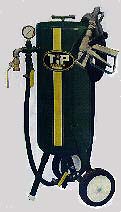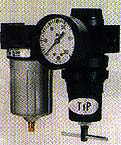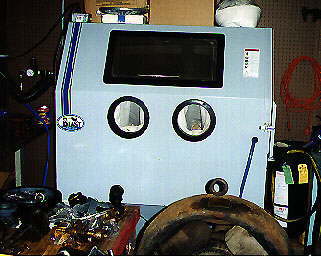Removing Rust from Antique Engines:
Previous discussion and email traffic through the antique-tractor group brought on the following tirade regarding cleaning of engine parts and the products required to get the job done...

I had found out the hard way that cleaning up rusty engine parts with steel wool and sandpaper just wasn't going to get me too far. After considerable research into what was available, I bought a model 99 abrasive blaster from the San-Blast division of Truman's Inc. in Canfield, Ohio and it looks to be everything that I expected. Damn, this engine hobby breeds things though, first one thing, then another! Now I'm off to pick up a new compressor since my old 1HP Sears just isn't going to be up to the job.
I looked at a Devilbiss model IR6E60VAD 6HP with 60 gallon tank, which is just like a Craftsman 17526N. I guess Sears has their models made somewhere and I think I've just found out where they get them. Prices (for the SAME unit): Sears $579.99 plus shipping, BJ's $390, Chase Pitkin $378.00. It has needle bearings for the crank, cast iron sleeves and stainless valves. When you buy something like this, you have to study it over and make a careful investment. Industrial CAST IRON is better of course, but you'll pay a lot of money for it. I'd rather save enough to pick up a bead blaster cabinet later on.
But, before I made the compressor purchase, I had received lots of email on the subject and so I took even more time to make the decision on which compressor. The toss up was between two units and I ended up with buying the DeVilbis 6.5hp 80 gallon 17cfm two stage unit. It is the PRO-4000 model and now stands like a BEHEMOTH in the corner of my garage, right next to the power panel. (At 25 amps I'm sure it'll use lots of power.) I had received all kinds of evil-eye dealer warnings about warranties and "we service what we sell", but the price ($799) at BJ's Wholesale got my attention.
The unit is 72" tall and 28" wide and its shipping carton was 30" by 32" and 6'4" tall. My S-10 Blazer can take 32" height by 34" width and about 6 feet with the back seat down. So, I told the fork lift operator to sit it down on the X behind my Blazer and we rotated it to the (belt guard) down position. We then leaned it over and slid it into the Blazer just clearing the raised back window. It fit and he was amazed! I've had a salt loaded Ford 2N rear wheel in there before so I guess the Blazer is weight tested. So off I went down the road with the wooden skid half way in on the tailgate on a cold and snowy day.
Back home, unloading was another story. The flimsy cardboard carton rails were of such poor strength that I wasn't going to put too much force on them for unloading. Fortunately, it's on a wooden skid, so I was able to pull it out and lower that to ground level. Standing the unit up was another story - it is TOP HEAVY! A call to my neighbor brought him to the rescue. It IS a TWO man job to stand one of these up, even from a 45 degree angle!

Well, it's in place now and awaiting some more of that breeding to take place that I mentioned above. A 30 amp circuit breaker, wire, regulator, filter for water removal, quick couplers, 1/2" hose, RESPIRATOR, etc. Is there an end to this tale? By the way, the company makes a very IMPORTANT and VALID POINT about using proper respiratory protection when doing any type of abrasive blasting. For more than occasional use, an air supplied hood/respirator should be used.
 email comments follow: email comments follow:
Gary Wylie wrote:
Although 80 gal is 'more' than 60, this parameter mostly affects how long you can run at a given pressure/volume prior to 'waiting'... I would consider either the 60 gal or 80 gal to be sufficient.
The second unit is spec'ed at 16.9 cfm @100 psi, whereas the first is 10.2@90psi; this leads me to believe the second is a two-stage compressor (i.e. this will give you a higher pressure and more air at that pressure than a single stage). A two-stage compressor of this type essentially will give you the capability to do anything you want in your home shop (or even small 'restorer' shop).
Notice that even though the second unit is only 'spec'ed' at 6.5 hp versus the 6.0 hp of the first, There is a much larger current draw for the second... This tells you the second hp rating is a much more 'honest' rating than the first (lots of cheaper compressors are rated at 'max' or peak hp (purely because it 'sounds' better!).. THESE ARE NOT SIMILAR MOTORS! The second is probably twice the power of the first.
If you do a LOT of work in your shop, and expect to do this for a long time, the second compressor will last longer than the first. If you think you might ever want to air a beadblast cabinet, or do any blasting then you should buy the second unit.
Mike Cobine (Doc) wrote:
Abrasive blasting is one of the most "air-thirsty" things you can do. Basically, you have cut the end of a hose off and blowing all the air out of it. I have blasted with a Sears 80 gal 6 hp and you drop pressure REAL FAST. And pressure is the name of the game in blasting. No pressure, no results.
So if you get a 125 psi compressor and hook up, the pressure will drop instantly when you squeeze the trigger. the compressor of course will not kick on until the switch hits about 85 psi and then you have lost 40 psi of pressure. that is a bunch. there is no way a 125 psi max compressor can maintain 125 psi for the blaster. It can't be done. The 175 will, with a regulator set to 125, the tank at 175, keep 125 on the regulated line all day.
If you plan of doing a bunch of them, or doing it as a semi-business thing of blasting and restoring other people's parts, then go for the 2 stage. I know the price is double, but if you want it for blasting, resting while it catches up will not cut it at all.
Professional abrasive blasting places typically have things like 175 psi at 50 cfm compressors or more. you just can't have enough cfm and pressure when blasting.
I have one of the typical $19.95 blaster guns with a hose for sticking in a bag of sand. With it, I run out of air real fast. I have an 80 gal tank and a 6 hp Sears compressor. I don't remember off hand how much time, as it has been a couple of years since I was trying to blast in earnest (the front frame of my race car), but it was roughly a minute or so at most.
In a mail exchange on the stationary engine mail list,
Charles R. Bryant writes:
A short while after starting to collect and restore engines I decided to get my own abrasive blasting equipment. First I bought a 5 HP, two stage, 80 gallon tank, Sanborn air compressor. (cost at that time approx. $800 from Sams)

My friend recommended the "99er" abrasive blaster. At this time it came with the cougar gun. Before using a full tank of abrasives I would have to wait for the compressor to catch up. Later they came out with the 38 Special gun. This was much better for my size compressor and now the compressor keeps up very well. A 5HP, single stage, 60 gallon tank, air compressor will work very well also.
Use a 1/2 inch I.D. hose as volume is very important. A pressure of approx. 95 to 110 psi works very well.

By mounting the water seperator-regulator on the blaster itself you will not have any moisture problem even on the most humid days.
Very important: wear gauntlet type gloves. My friend didn't once and abrasives remove skin very fast.
Of all the hoods and masks I have used, I like the half mask respirator with their lowest price hood. Using the paper mask the hood lense fogs up. Keep a good supply of hood lenses on hand. I buy note book leaf protectors at the office supply store and cut them to cover the hood lense. This saves money.
For gun nozzles, if you are going to do much blasting buy the carbide nozzle. The ceramic nozzles don't last long and the problem is you are gradually using more air and abrasives as they wear.
It is very important to use dry fine abrasives. I even sift the new bags of media when I fill the tank. TPs sifter screen is a must. For sand I go to the local sand and gravel company and buy the regular fine sand for sandblasting. A 100 lb. bag costs $2.50. The white sand sells for over $5.00 for a 100 lb. bag.
When abrasive blasting I put tarps down and on the first go around I recover about 75% of the first tank. After that as it breaks down the dust blows away. My neighbor says he has the only swimming pool in town with a sandy bottom and sandy beach. At least his wife hasn't complained since I moved the operation out back (one windy day I hadn't noticed she had opened all the windows after cleaning house).
It is very important to scrape off all the grease before abrasive blasting as it will not remove hard grease.
With my sandblaster I have done tractors, truck frames and of course dozens of engines. With a sandblaster and bead blaster you will not lack for friends. I cannot recommend a company and their products and service more highly then TP.
Here is the approximate cost of the equipment I have mentioned:
- Air Compressor (5HP, two stage, 80 gal. tank 900.00
- 99er abrasive blaster 379.00
- Sifter screen 8.00
- Hood 25.00
- Gloves 16.00
- Regulator and water seperator 85.00
- Carbide nozzle 70.00
- Respirator 40.00
- 50 foot hose 1/2 in. I.D. 40.00
- 12 hood lenses 16.00
Bill Dickerson writes:
Moisture is a big problem, as is any soft substance on the material you are trying to clean. I've seen a couple of great tips on moisture problems here. As you mention grease - but I'd add that anything that is soft, or resiliant will simply cause the abrasive to be either embedded in it, or bounce off of it, making further blasting that much more difficult. You get MUCH better job if you spend a bunch of time prepping your parts - clean them first of any and all grease, and in fact, even paint that may be soft, or real thick if you can scrape it off will help a bunch.
And remember - anything that is not cast iron or steel will either go away, or be damaged while you blast. Move all prize posessions a great distance away before starting - this stuff bounces quite a distance! Move all vehicles, kids, close windows, etc., and be ready to walk right straight into the shower when you are done. :-)
Abrasive blasting is just a start in the process - you still aren't ready to paint after blasting...
And Charlie returns with more on glass bead blasting:

Bead blasting is the same as other abrasive blasting except it is done in a cabinet using different and more expensive abrasives. It still requires about the same amount of air as other blasting, depending on the size of your nozzle. It is excellent for small parts. Depending on the size of your cabinet you can do small engine blocks and fly wheels.
The most common abrasive used is glass beads. They look like fine white sand. They are good for rust but do not take off paint easily and hard paint sometimes not at all. The beads do not erode the metal as sand does so does not get off the real deep rust. It does leave a lot smoother finish though and is good for brass, bronze and aluminum. Aluminum oxide abrasive gets off rust more easily but is nasty stuff to use and I will never put it in my machine again.
For paint we use plastic beads. Plastic beads do a fine job of taking off paint but will not take off rust. So for anything painted (depending how hard the paint is) I drain out the glass beads and put in the plastic and then go back to glass to remove the rust.
As I said these abrasives are more expensive than sand. TP lists glass beads for $30.50 plus shipping for a 50 lb. bag. Plastic beads for $109 for 50 lbs. Plastic beads do not break down as easily and a 25 lb. bag would last me at least a couple of years. In the course of a year I use about 4 bags of glass beads (thats because I have a lot of friends). I buy my beads through through a company that sells air tools and equipment and pay $21 for a 50 lb. bag.
TP sells plans to build your own cabinet out of plywood. But you still have to buy the rest of the parts like the gun, glass window, regulator, gloves, and dust collector so you are looking at another $300 or more. Because I have an extra large cabinet I ended up paying over $900 for a dust collector I was satisfied with. Being responsible for purchasing and setting up 6 bead blasters at my former place of employment I had mine custom built so I have quite a few bucks in it.
If anyone has anything to add to this please do so. Call TP and get their catalog. They show quite a variety. You can always tell when a "lefty" has been using a bead blaster - they always get the window.
Rob Skinner writes:
I was hanging out at the sandblast guy's shop yesterday afternoon lamenting about the difficulty I have blasting certain items. I've been using #2 glass beads with a low volume compressor, which works just fine on most projects. However, on the tough jobs, blasting can become an ordeal. I asked him what he had that would give me the nice finish of glass beads, but cut like aluminum oxide. He explained to me all the options available, and then said that he had what I needed: plastic. I said, "Plastic? No way." He said "Way! But most people don't use it 'cuz it costs $2.75 a pound." I quickly fired up the ol' mental calculator and determined that ($2.75/lb.)(50lb.) = way too much.
After he picked me up off the floor, we continued to roam the racks of supplies until he stopped and said, "here, try this." He told me "this" was crushed glass, an angular media, like aluminum oxide. The cutting speed and finish produced by the crushed glass would be between that of glass beads and aluminum oxide. The price was the same as for beads. We loaded up a bag and I headed home.
I dumped the bag into the blaster this afternoon, and guess what? This stuff works really well. I blasted a piece that was covered in latex paint. The beads wouldn't touch it, but the crushed glass cut right through the paint. The finish on the metal was a little rougher than with beads, but not so rough as to cause a problem. I haven't tried it on aluminum or brass yet, but I suspect that it will work ok.
UPDATE: Retired and living in Florida now. The DeVilbis made its way down on the moving van ($$$) and I have also acquired the TiP bead blasting cabinet. Glass bead blasting is the cat's meow when it comes to restoring small engine parts and the 99er has sat in the corner a lot because of this. Recently it has come to life again in the restoration of my 4HP IHC Famous engine - the ONLY way to blast the huge flywheels and the main base block. I have installed pipe across my garage with outlets for bench air cleaning, the booth blaster with regulator and water separator, and an outside tap for the 99er.
UPDATE: For some current bead blasting results, see my FULLER & JOHNSON engine project!
| 

 Page!
Page!